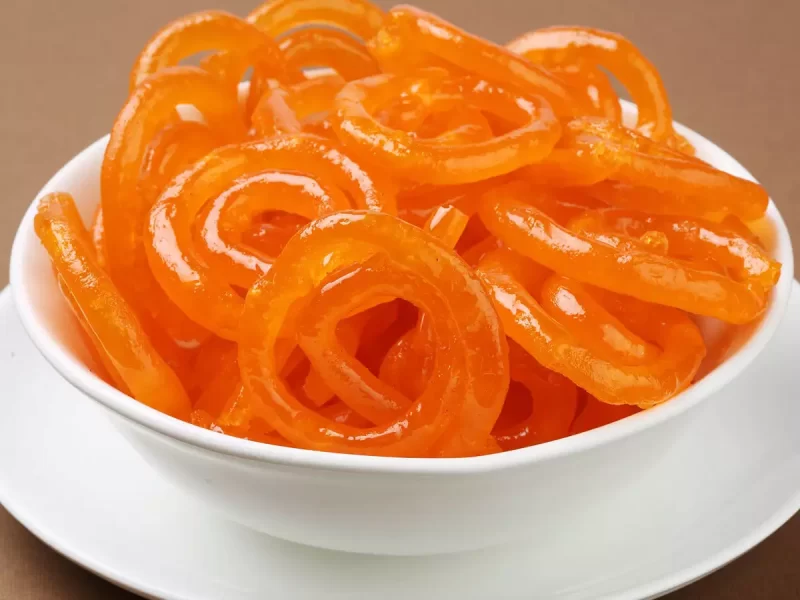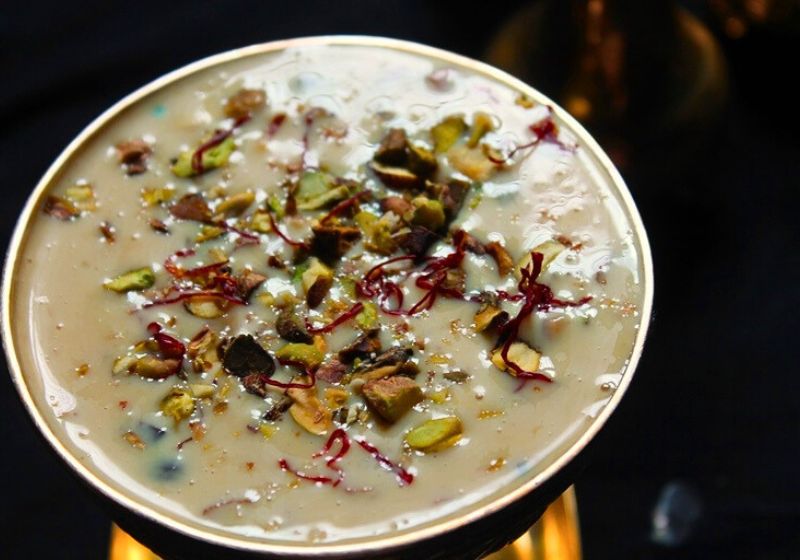Radhaballavi Recipe: If you’re a fan of pooris and kachoris, then you must try Radhaballavi – a Bengali specialty dal puri. Similar to Luchi, a quintessential breakfast dish in West Bengal that every Bengali swears by, Radhaballavi holds a special place in Bengali cuisine. These tender and tasty puris are crafted from all-purpose flour (maida) and filled with a flavorful mixture of spiced urad dal (split black gram). I’ve tweaked the recipe by adding whole wheat flour (atta) to enhance its nutritional value.
The dal used can be either urad dal or chana dal, with chana dal being more common in wedding feasts. Radhaballavi is a popular street food snack in Bengal and is often served with Dum Aloor. It’s also a traditional dish made during Durga Puja festivities.
I received several recipe requests for Radhaballavi, and I thought Durga Puja would be the perfect time to prepare these lightly spiced dal puris. I referred to various cookbooks for the recipe, and for the stuffing, I opted for urad dal.
These puris are reminiscent of Urad Dal Kachori that I shared some time ago, but with a milder stuffing that has a subtle sweetness. Radhaballavi pairs beautifully with Dum Aloo or Cholar Dal. Additionally, this recipe is a no onion no garlic version.
For the dough, I used a combination of all-purpose flour (maida) and whole wheat flour (atta) in equal parts. Making Radhaballavi does require some time and preparation work, similar to making kachoris or samosas, both of which are favorites at home. Therefore, once in a while, I indulge in making Punjabi samosas and various types of kachoris.
How to Make Dal Puri or Radhaballavi Recipe
A) Making Puri Dough:
- Take 1 cup of all-purpose flour (maida) and 1 cup of whole wheat flour (atta) in a large bowl or wide plate.
- Add 2 tablespoons of ghee and 1 teaspoon of salt to the flour.
- Mix the ghee and salt thoroughly with the flour.
- Gradually add ⅔ to ¾ cup of water in parts to the flour mixture.
- Knead the mixture into a smooth, pliable dough. Cover it with a moist cloth and let it rest for 30 minutes.
B) Making Spice Mix:
- Heat a pan or kadai over low heat and add 1 teaspoon each of fennel seeds and cumin seeds.
- Mix the seeds well and then add 1 to 2 dry red chilies (broken and seeds removed).
- Stir the spices often and roast them until aromatic, taking care not to burn them.
- Turn off the heat and add 2 thin strands of mace to the spices. Let them cool down.
- Once cooled, transfer the spices to a spice grinder or small grinder jar.
- Grind the spices into a fine powder and set aside.
C) Soaking and Grinding Urad Dal:
- Rinse ½ cup of urad dal in a bowl and soak it in 1 cup of water for 4 to 5 hours or overnight.
- After soaking, drain the water from the urad dal and set it aside.
- In a grinder jar, add the soaked urad dal along with 1 inch of roughly chopped ginger. You can also add 1 chopped green chili at this point.
- Add 3 tablespoons of water and grind the mixture into a semi-coarse consistency. Ensure it’s neither too coarse nor too fine. Set aside.
D) Making Urad Dal Stuffing:
- Heat ½ tablespoon of ghee in a heavy kadai or pan over low heat.
- Add a generous pinch of asafoetida (hing) to the heated ghee and stir well.
- Using a spatula, add the ground urad dal paste to the pan.
- Mix the urad dal paste well on low heat.
- Add 1 teaspoon of sugar and salt to taste.
- Saute the mixture with continuous stirring for 3 to 4 minutes on low heat until it begins to gather around itself and sticks to the pan.
- Add the ground spice powder to the mixture and mix well. Turn off the heat and adjust the seasoning if necessary.
- Allow the mixture to cool down to warm temperature.
- Form small to medium-sized balls of the urad dal stuffing. If the mixture feels sticky, apply some oil or ghee to your palms while shaping the balls. Cover and set aside.
- Note: The paste stuck to the bottom and sides of the pan can be scraped off and added to the filling while shaping the balls.
Assembling, Stuffing, and Preparing Radhaballavi Recipe:
- After 30 minutes, divide the dough into 10 to 12 equal-sized balls. Cover them with a moist cloth and set aside.
- Take one dough ball and lightly grease both sides with oil.
- Flatten the dough ball with your fingers or a rolling pin (belan).
- Place a ball of urad dal stuffing on the flattened dough and gently press it down to flatten slightly.
- Bring the edges of the dough together over the stuffing and seal them at the center. Remove any excess dough.
- Ensure that the puri is well-sealed without any cracks.
- Flatten the puri with your fingers.
- Roll out the puri gently with a rolling pin to achieve a medium to slightly thin consistency. Repeat this process for all the dough balls. Keep them covered under a moist cloth to prevent drying out.
Frying Radhaballavi Recipe:
- Heat oil for frying over medium heat. To check the oil temperature, add a small piece of dough. If it rises gradually and steadily to the surface, the oil is ready for frying. If it rises too quickly, the oil is too hot, so reduce the heat. If it doesn’t rise at all, the oil is too cold, so increase the heat.
- Carefully slide a prepared dal puri into the medium-hot oil.
- After a few seconds, the puri will float to the surface and start puffing.
- Gently nudge each puri with a spoon to ensure even puffing.
- Fry until the base becomes light golden in color.
- Using a slotted spoon, gently flip the dal puri to fry the second side until it becomes light golden.
- Press the edges of the puri gently with the slotted spoon while frying to ensure they are fried evenly.
- Remove the fried radhaballavi with a slotted spoon and allow excess oil to drain back into the kadai. Some puris may not puff up well if not sealed and rolled properly due to the dal filling.
- Place the fried radhaballavi on a kitchen paper towel to absorb excess oil. Fry all the dal puris in the same manner. If the filling is finished but there is still some dough left, make puris from it.
- Serve the radhaballavi hot or warm with Bengali dum aloo or Cholar dal.
Ingredients: Radhaballavi Recipe
For Poori Dough:
- 1 cup all-purpose flour (maida)
- 1 cup whole wheat flour (atta)
- 2 tablespoons ghee
- 1 teaspoon salt
- ⅔ to ¾ cup water, or as required
For Soaking & Grinding Urad Dal:
- ½ cup urad dal (115 grams)
- 1 cup water for soaking
- 3 tablespoons water for grinding
For Spice Mix:
- 1 teaspoon fennel seeds (saunf)
- 1 teaspoon cumin seeds (jeera)
- 1 to 2 dry red chilies, broken and seeds removed
- 2 thin strands of mace
For Urad Dal Stuffing:
- ½ tablespoon ghee
- 1 generous pinch asafoetida (hing)
- 1 inch ginger, roughly chopped
- 1 teaspoon sugar
- Salt, as required
Other Ingredients:
- Oil for deep frying
Conclusion:
Radhaballavi Recipe, a Bengali specialty dal puri, is a delicious and satisfying dish that can be enjoyed as a snack or part of a meal. With its flavorful urad dal stuffing and crispy exterior, it’s sure to be a hit among your family and friends. By following the step-by-step instructions provided, you can easily recreate this traditional Bengali delicacy at home.
FAQs about Radhaballavi Recipe
Can I use only all-purpose flour or whole wheat flour for making the dough?
Yes, you can use either all-purpose flour (maida) or whole wheat flour (atta) alone for making the dough. However, using a combination of both enhances the texture and nutritional value of the puris.
What can I serve with Radhaballavi?
Radhaballavi pairs well with Bengali dum aloo or Cholar dal. These accompaniments complement the flavors of the dal puris perfectly.
Can I make the urad dal stuffing in advance?
Yes, you can prepare the urad dal stuffing ahead of time and store it in the refrigerator. Ensure it is cooled completely before refrigerating. Allow it to come to room temperature before using it to stuff the puris.
How do I know if the oil is at the right temperature for frying the puris?
To check if the oil is at the correct temperature, add a small piece of dough to the oil. If it rises gradually and steadily to the surface, the oil is ready for frying. Adjust the heat accordingly if it rises too quickly or too slowly.
How can I ensure that the puris puff up well during frying?
Gently nudge each puri with a spoon while frying to ensure even puffing. Press the edges of the puris gently with a slotted spoon to ensure they are fried evenly on all sides.


